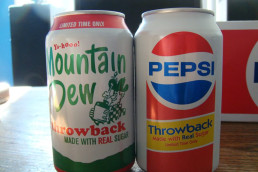With all the trends going around in marketing/advertising, the retro branding strategy has become increasingly popular. It not only creates a sense of nostalgia that resonates with consumers on an emotional level but it reminds us of a company’s value over a long period of time.
So, what is it about this retro branding strategy trend that makes it so influential in today’s marketing landscape? How does it influence the way a brand is viewed or perceived, and most importantly, how does it influence consumers’ purchasing decisions?

What exactly is a ‘retro branding strategy’?
Retro branding is when companies bring back old styles and designs to make people feel nostalgic. This can include using marketing and advertising tools like old logos, old packaging, and even vintage style ads. By using ‘blasts from the past’, brands hope to make people remember good times from their younger years and feel a deeper, more authentic connection with their brand.
The psychology and appeal behind nostalgia
According to many psychologists, nostalgia serves as a coping mechanism, which allows folks to seek solace and comfort in fond memories during times of stress or uncertainty in their lives (something we all need post-pandemic!). With the current economy, this make more sense as to why many brands are looking to hop on the retro trend as a strategy.
When consumers encounter forms of retro branding, it triggers nostalgic emotions associated with simpler times, childhood memories, or well-received cultural moments from the past. In turn, this emotional response creates a sense of familiarity and warmth on a subconscious level, making retro-inspired brand designs and campaigns deeply appealing to consumers.
Putting retro branding strategies into practice
You notice other big brands reverting back to past looks and feels, so why not give it a shot if you’re due for a brand refresh? However, this retro strategy comes with a lot of preparation to make it a success. Below are some tips to get started:
Researching Target Audience’s Nostalgic Preferences:
- Conduct research into the target audience’s demographic data and cultural background.
- Analyze past trends, icons, and cultural moments that resonate with the target audience.
- Utilize surveys and focus groups to gather insights into specific nostalgic preferences.
- Identify key elements from the past that evoke strong feelings of nostalgia among the target audience.
Incorporating Retro Elements into Branding:
- Redesign logos, packaging, and marketing materials to reflect vintage aesthetics.
- Integrate retro-inspired imagery, fonts, and colors into branding elements.
- Create advertising campaigns that evoke the spirit of a past era.
- Use storytelling to highlight the brand’s heritage and connection to the past.
Balancing the Old with the New:
- Maintain authenticity while incorporating retro elements into branding.
- Find creative ways to modernize retro aesthetics and make them relevant to contemporary consumers.
- Experiment with blending vintage styles with modern design trends.
- Continuously monitor consumer feedback and adjust branding strategies accordingly to ensure they resonate with the target audience.
Getting started with retro branding
In today’s brand landscape, retro branding is a big deal because it taps into our love for the past on an emotional level. Brands are using old-fashioned styles to make us feel connected and nostalgic, standing out amongst the noise and making us feel like we’re part of something special. By mixing old looks with new ideas, the retro branding strategy trend helps brands create strong emotions, and continue to grow – even in our fast-changing modern digital world.
Want assistance with your retro branding? Our brand strategist can help. Contact aaron@weareblueridge.com.

